
|
|
|
|
BY: SUN STAFF
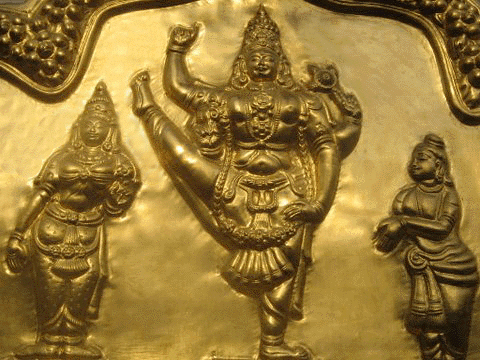
Lord Trivikrama Mar 14, CANADA (SUN) — A serial exploration of the holy sites visited by Lord Caitanya. Trimatha
Today we return to the state of Tamil Nadu, and another of the tirthas visited by Lord Caitanya Mahaprabhu. This location, Trimatha, is in a cluster of sites relative close together, but with other locations interspersed in the list that are quite a distance away. Trimatha is mentioned in the Summary of Sri Caitanya-caritamrta Madhya 9:
Madhya lila 9 "A summary of the Ninth Chapter is given by Srila Bhaktivinoda Thakura. After leaving Vidyanagara, Sri Caitanya Mahaprabhu visited such places of pilgrimage as Gautami-ganga, Mallikarjuna, Ahovala-nrsimha, Siddhavata, Skanda-ksetra, Trimatha, Vrddhakasi, Bauddha-sthana, Tirupati, Tirumala, Pana-nrsimha, Siva-kanci, Visnu-kanci, Trikala-hasti, Vrddhakola, Siyali-bhairavi, Kaveri-tira and Kumbhakarna-kapala." Later in Madhya Lila we find specific information about Trimatha: Madhya 9.21
"At the holy place known as Skanda-ksetra, Lord Sri Caitanya Mahaprabhu visited the temple of Skanda. From there He went to Trimatha, where He saw the Visnu Deity Trivikrama. Madhya 9.22
After visiting the temple of Trivikrama, the Lord returned to Siddhavata, where He again visited the house of the brahmana, who was now constantly chanting the Hare Krsna maha-mantra."
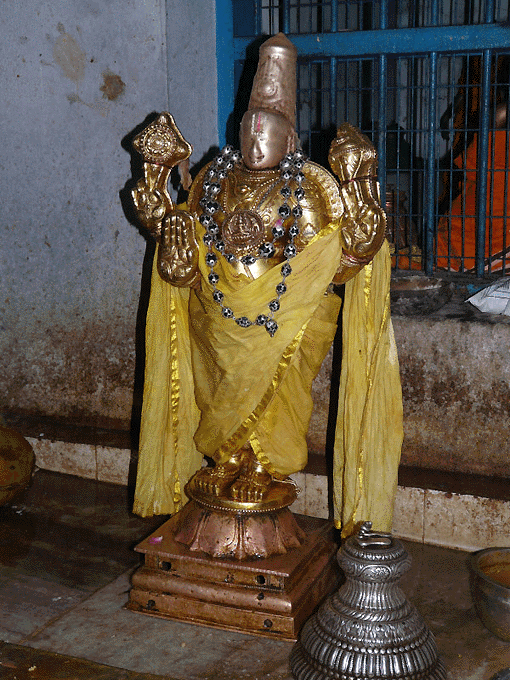
Thirukovalur Ayan – Trivikrama at Thirukovalur We find no other references to Trimatha in Caitanya-caritamrta or elsewhere in Srila Prabhupada's books. A reference previously cited in our tirtha-yatra series, the book Chaitanya's Pilgrimages and Teachings by Jadunath Sarkar, M.A. (Calcutta 1913), which represents the author's commentary of Caitanya-caritamrta Madhya Lila, states the following: "He bathed in the Ganga Gotami (Godavari). At Mallikarjuna He visited the shrine of Mahesha, where He made all the people recite Krishna's name. He beheld the Rmaddsa Mahdeva, and also the Man-Lion at Ahobal, bowing to and glorifying the latter. At Siddhabat is the image of Sita's lord; the Master bowed to the image of Rdma and sang hymns. There He was invited by a Brahman of the place, who incessantly took Rama's name and no other. After passing the day in his house as his guest, the Master proceeded on. At Skanda Kshetra He visited Kirtika, and at Trimatha the god Tri-bikrama, whence He returned to that Brahman's house at Siddhabata, but found him chanting Krishna's name!" We find additional details in this lecture from HH Bhakti Shravan Tirtha, a member of another Gaudiya Vaisnava branch: "At the holy place known as Skanda-kshetra, Lord Sri Chaitanya Mahaprabhu visited the temple of Skanda, Kartik the son of Goddess Parvati and Lord Shiva. From there He went to Trimatha, where He saw the Vishnu Deity Trivikrama. Lord Chaitanya Mahaprabhu left the next day and arrived at Vriddhakasi, where He visited the temple of Lord Shiva. Vriddhakasi's present name is Vriddhacalam. It is situated in the southern Arcot district of Tamil Nadu on the bank of the river Manimukha. This place is also known as Kalahastipura." We have already covered Vrddhakasi-tirtha in this series, and know it to be located in the Cuddalore district of Tamil Nadu. Vrddhakasi is also called Vriddhacalam, in Tamil it is Thirumudukundram, and its ancient name is Kalahastipura.
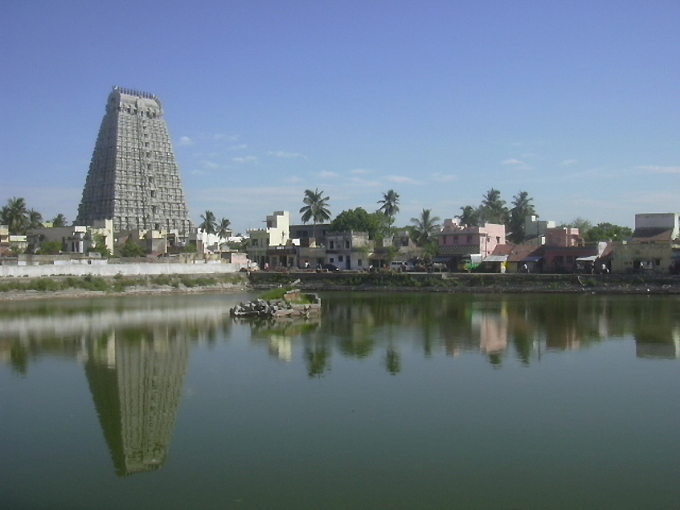
Tirukkovalur Veerattam – Lord Trivikrama's Temple at Tirukkovalur Although the specific name of the Trivikrama temple Lord Caitanya visited is not given in Madhya 9.21-22, there are two ancient Trivikrama temples very close to Vriddhacalam, just outside the northwestern and southeastern borders of South Arcot district. It seems very likely that Mahaprabhu would have visited both of these tirthas. According to Bhakti Shravan Tirtha Swami, Lord Caitanya 'left Trimatha the next day and arrived at Vriddhakasi'. This seems to indicate the two are quite close together, although it does not specifically say how many days passed before Mahaprabhu arrived at Vriddhakasi – it could have been the next day, or several days. Altogether, there are four Divya Desams in Tamil Nadu where Lord Trivikrama resides, out of the entire 108 Vaisnava Divya Desams. The first, Tiruoorakam, is located at Kanchipuram. The second, Tiruneermalai, is at Pallavaram, very close to Tiruoorakam – just 10 kilometers south, on the opposite bank of the Palar River. So both of these temples are located approximately 175 km north of Vriddhachalam.
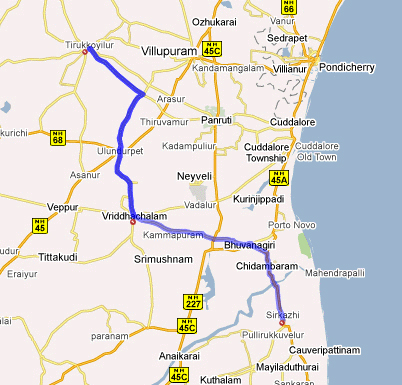
Distance from Vriddhakasi (Vriddhacalam) to nearby Trivikrama Temples The third, Kaazhicheeraama-vinnagaram, is much closer to Vriddhachalam, being just 65 km southeast, in the village of Sirkazhi. Likewise the fourth, Tirukkovalur at Villupuram, is just 63 km north of Vriddhachalam. So it seems very likely that the Trivikrama temple Lord Caitanya visited near Vriddhachalam, as referred to in Madhya 9.21, is either Tirukkovalur or Kaazhicheeraama-vinnagaram. Aside from the location of the Trivikrama temple at Trimatha, another great question arises with respect to the distances the Lord traveled during this leg of His journey. The statement made in Madhya 9.22 is that after visiting the temple of Trivikrama the Lord returned to Siddhavata, where he found the brahmana who had stopped chanting the name of Rama, and taken up chanting the Maha-mantra. In an earlier segment on Siddhavata we find ample evidence for the location of that tirtha, which is one of the sacred gateways to Sri Sailam in Andhra Pradesh. Lord Caitanya is said to have visited this place after seeing Ahovala-nrsimha.
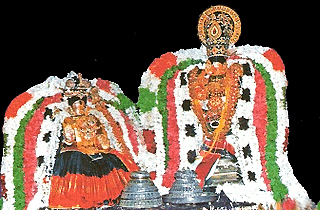
Lord Trivikrama at Kaazhicheeraama-vinnagaram So regardless of which Trivikrama temple the Lord visited, we have confirmed the locations of both Vriddhakasi and Siddhavata, and sastra seems to clearly state that Lord Caitanya traveled from Siddhavata, south to Vriddhakasi, then back again. Yet the distance between these two is nearly 900 kilometers! Traveled on foot, that is a very long way to go once, what to speak of twice. This appears to be one of the many mysteries associated with Caitanya Mahaprabhu's glorious sankirtana pada-yatra in South India. When considering the Lord's visit with Sri Trivikrama, we are reminded of the inconceivably giant footstep taken by Trivikrama-avatar. Likewise, who could hope to count Lord Caitanya's steps, or measure them in any sort of mundane way? We can only conclude that certain aspects of Sri Caitanya's inconceivable pastimes are hidden from view, and may be disclosed some time in the future by the Vaisnavas. In his Bhakti Ratnakara, Srila Kavi Karnapuram has this to say: "Although Thakura Vrndavana dasa described the pastimes of Mahaprabhu he did not dare mention the Lord's South Indian tour. 213
| |